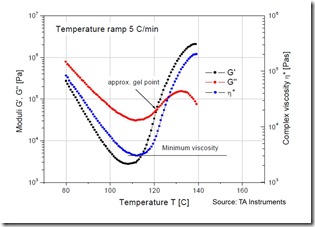 In the next couple months we will be providing a “deep dive” into the field of rheology and specifically how rheology is a key tool in the characterization of thermosets. But first a little background. I am a classically trained rheologist having completed my Ph.D. at Northwestern University under the guidance of Prof. William W. Graessley. To those in the field, Prof. Graessley was one of the key contributors in the polymer rheology field in the 70’s – 90’s. I was a student at NU from 1977-1982 and my research was on the rheological properties of model polymers with well controlled molecular structures including near mono-disperse molecular weight distributions, linear and star-branched model polymers, and most interestingly, linear mono-disperse polymers with varying sidegroup content so I could measure the effects of both long-chain and short-chain branching on polymers with precise chain architecture and molecular weights. I had a blast.
In the next couple months we will be providing a “deep dive” into the field of rheology and specifically how rheology is a key tool in the characterization of thermosets. But first a little background. I am a classically trained rheologist having completed my Ph.D. at Northwestern University under the guidance of Prof. William W. Graessley. To those in the field, Prof. Graessley was one of the key contributors in the polymer rheology field in the 70’s – 90’s. I was a student at NU from 1977-1982 and my research was on the rheological properties of model polymers with well controlled molecular structures including near mono-disperse molecular weight distributions, linear and star-branched model polymers, and most interestingly, linear mono-disperse polymers with varying sidegroup content so I could measure the effects of both long-chain and short-chain branching on polymers with precise chain architecture and molecular weights. I had a blast.
Then it was time to find a job. Prof. Graessley told me to send my resume to IBM. I said “What?, they are a bunch of electrical engineers and programmers.” Since he was the wise professor and industry giant, I took his advice and landed a job in 1982 at IBM in Endicott, NY (little known fact, the birthplace of IBM). I was in the Polymer and Process Science department in the Materials Engineering Group. The interesting aspect of my new challenge was that most of the polymers used in electronic packaging are thermosets. I was the second rheologist at IBM at the time (Dr. Thor Smith was at IBM Research in Almaden at the time). As I was about to find out, thermosets have fascinating rheological properties both in the uncured state and as they cure.
One of my favorite undergrad classes was organic chemistry (sick, I know!). I got to do a lot of synthetic chemistry making my model polymers at NU, but my IBM work included a lot of thermoset cure chemistry and formulation. Over the next 30 years, I spent a large part of my professional career studying the role of cure chemistry on the rheological properties (chemorheology) and developing a deep understanding of curing mechanisms, thermoset characterization methods, and as a result a very deep knowledge-base of polymers used in electronic applications.
The next series of posts will focus entirely on the rheology of thermosets:
- Rheological methods specific to thermosets
- Rheology of uncured, formulated thermosets (dispensing, prepregging, etc.)
- Chemorheology (curing process for thermosets for example lamination, adhesives, etc.)
- Role of vitrification on curing (and how to experimentally measure)
Should be a fun set of posts. If you are not into rheology, we might intersperse some posts on biopolymers. Dr. Humphreys has some more interesting topics in biopolymers to share and Dr. Prime will be back with some posts on kinetic analysis and some case studies. Thanks to all of our readers, we get about 2800 people reading this blog each month!

Leave a Reply